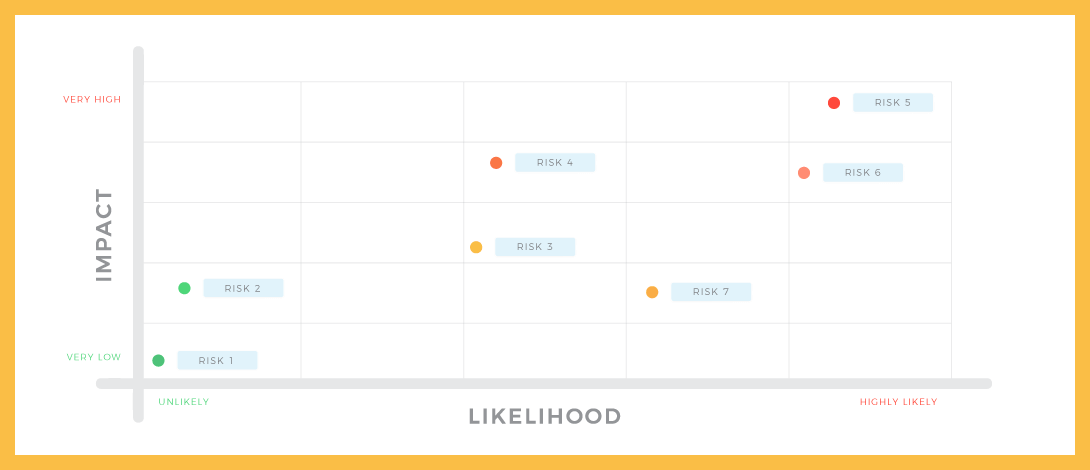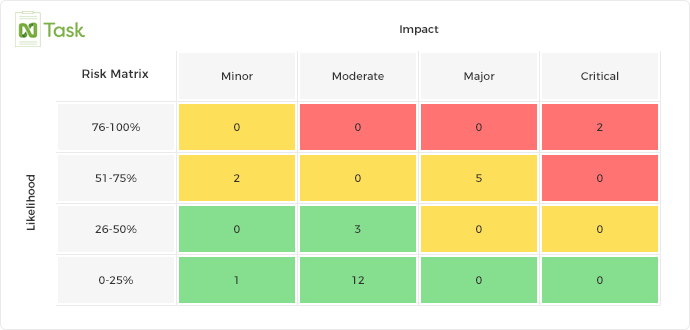How to Use the Risk Assessment Matrix in Project Management
Before you can solve, you have to see, and a risk matrix can help with just that.
Join the DZone community and get the full member experience.
Join For Free
In today’s age of ever-fluctuating market trends, risks are inevitable. Whether you’re running a start-up or are a part of a giant corporate culture, eventually you’ll be faced with risks that need your utmost dedication for timely mitigation.
Whenever you’re beginning any new task, one of the most important questions that are highly likely to cross your mind is, "What could possibly go wrong?" Some things are bound to go wrong during a project’s lifecycle.
It’s not easy to assess risks, let alone managing them, and if you are not quick to evaluate and control them, all your resources will be at stake. Companies spend plenty of time and financial resources to come up with the right kind of risks to devise valuable measures for lessening their impact.
There are some essential steps that are to be taken for successful risk management. The process of risk management begins with risk assessment, which moves forward to risk analysis, and what needs to be done to minimize the risks. Let’s have a quick glance at some of these steps and what each one of them entails.
Risk Assessment
Identifying the risks associated with business or business operations is one of the first steps in risk management. This shows that you’re proactive enough to minimize the damages as much as possible.
Some companies develop checklists from previous experiences of past projects for risk identification to manage risks. These checklists are essentially developed to identify potential risks associated with each new project.
You might be asking, "What happens after the risks are identified?" A key process of risk management called risk analysis begins.
Risk Analysis
Risk analysis is no child’s play. There’s a series of steps that need to be vigilantly taken for effective management of risks. After the company or a team has been successful in pitching all the right potential risks, the next step is to carefully evaluate them.
Companies need to be hawk-eyed when it comes to the analysis of risks. It’s imperative to thoroughly examine each and every factor associated with them and their possibility of occurrence for designing a strategy that will be apt in tackling them.
Sounds like a lot of work? This is where risk assessment matrix comes into play.
What is the Risk Matrix?
The Risk Matrix is also known as the Probability Matrix or Impact Matrix. It is an effective tool that assists in risk evaluation by considering the probability or likelihood against severity linked with the potential risks of a project.
Let’s have a look at this risk matrix by nTask and understand how it helps in visualization of risks for taking timely decisions:

The matrix consists of a grid, with Likelihood or Probability of occurrence at Y-axis and the consequent impact on X-axis. These two elements are considered for accurately depicting the nature of a risk.
The probability is visualized in terms of its likelihood but can be shown in terms of percentage as well, whereas the severity is shown in terms of its possible impact.
Risk Likelihood
The likelihood of a risk is broken down into four parts, usually:
- Very likely
- Likely
- Possible
- Unlikely
- Very unlikely
Risk Probability
The probability of the risk’s occurrence is recorded in percentages, usually:
- 0-25%
- 26-50%
- 51-75%
- 76-100%
Risk Impact
Normally, the consequent impact has 4 dimensions:
- Minor
- Moderate
- Major
- Critical
The grid is used to assign a particular number to the risk which is obtained by multiplying Probability with Severity or Impact. The resulting figure helps in understanding the nature of risk and what needs to be done in order to minimize it.
Apart from these divisions, there are three major zones inside the matrix as well. After the calculations are done, the quantified risk falls into these three zones:
- A low-risk zone that is considered acceptable (Yellow);
- A moderate risk zone that may or may not be acceptable (Green);
- A high-risk zone that is considered to be critical or unacceptable (Red).
These zones make the result of risk matrix more transparent by giving out a clear-cut division regarding the future steps that need to be taken.
Let’s explore some of the advantages of the Risk Matrix and how it can be effectively utilized for risk management.
Advantages of Risk Matrix for Risk Assessment
- Helps in prioritizing the Risks with the level of severity
- In planning risks, it helps with neutralizing the possible consequences
- Helps in analyzing the potential risks with minimal effort
- Assists in improving the safety measures of the organization
- Gives an overall view of the potential risks of a project to the team
Risk Matrix for Risk Management
You might have heard of the quote, "The greater the risk, the greater is the potential reward." If you don’t take any risk to step out of your comfort zone, you’ll never improve your current position.
But that doesn’t mean there is no need for proper risk management. Without it, you can possibly create havoc in your organization and can be met with some unforeseen circumstances whose control will not be in your hands. This can be tackled perfectly with Risk Assessment Matrix.
Utilizing risk matrix for risk management will not only reduce the likelihood of the risk, but will reduce the magnitude of its impact on operations as well. It provides timely data that quantifies the threats and greatly facilitates the organization to take some coherent steps for decreasing the potential chaos that might occur in case of an ambiguity.
The numerical values in the risk matrix provide a powerful way to depict the company’s exposure to risks and how much effort is needed to minimize them. They make the entire situation clear by making use of each division inside the matrix and give insights regarding the future approaches that need to be adopted.
Summing Things Up
It’s important to understand that a risk matrix is only a tool, not a complete solution for your needs. It all comes down to the intellectual worth of the people interpreting the matrix’s results. Alternatively, you can a risk management tool to help you identify and assess the likelihood and probability of risks of your projects.
A carefully sorted out strategy for risk mitigation always comes in handy in case of unforeseeable events and is a great means to equip the team with an effective contingency plan.
The essence of the story? Risk management should be a mandatory requirement whenever a new project planning is being done for staying as informed about the risks as possible.
Published at DZone with permission of Fred Wilson, DZone MVB. See the original article here.
Opinions expressed by DZone contributors are their own.

Comments